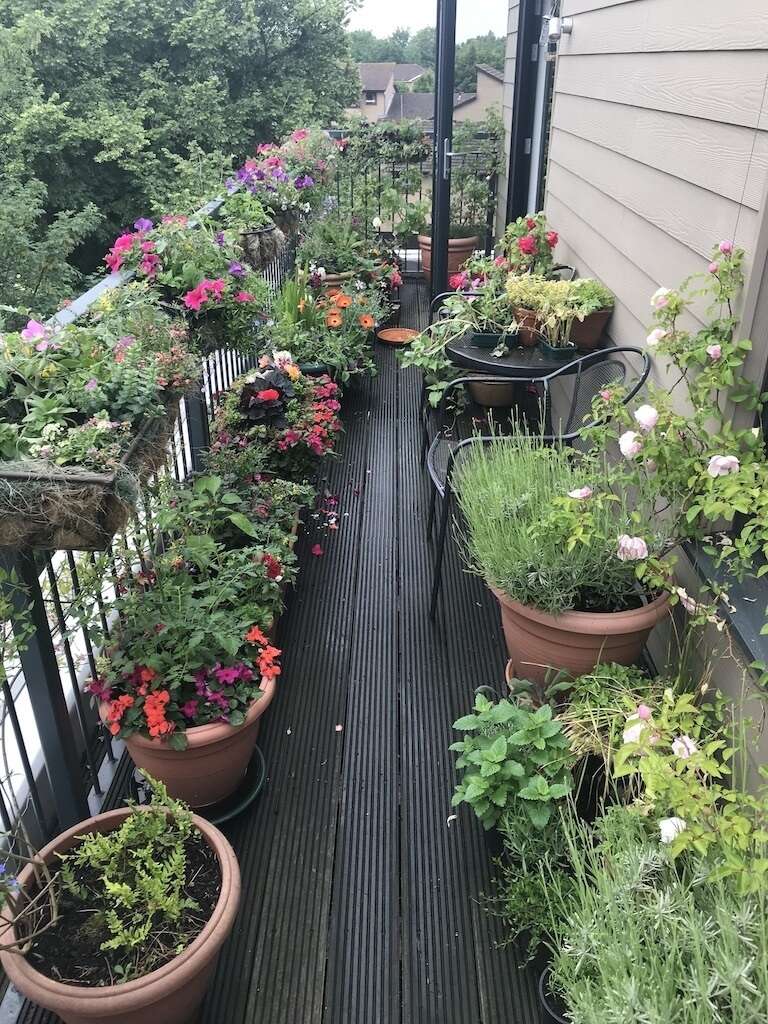One man and his organic plot - all organic gardens great and small

You might need to think about things a little differently, but all the principles of organic growing can be covered to bring you a thriving space full of food, colour and life.
Here are my top tips for small space success:
Think in three dimensions
Every inch matters in a small garden, so think carefully about your design. You may only have a few square meters of ground, but think how much more space you have on offer if you grow up instead of out. Trellis, walls, arches and obelisks are great features that plants can climb up and grow around. Not only will you get more from your space, but you’ll enjoy a much fuller and more interesting garden.
Find room for wildlife
Small gardens, yards and balconies can be just as welcoming to wildlife as large spaces. Make sure birds are fed and watered; small birds such as blue tits will pick off any early signs of aphids we should do our best to encourage them. I have a bird feeder attached to my window that is visited regularly by a whole host of birds. A small habitat pile of twigs and straw packed into a spare pot will provide a haven for beneficial garden predators.
Bird boxes, bee and bug hotels can all be mounted on an external wall and provide useful habitat in the smallest of spaces, and if you have a north-facing wall why not consider a bat box? It’s true what they say – if you build it they will come.
Composting on a small scale
Small spaces should still have room for composting of some kind. Wormeries are a great option, but make sure you do your homework on their welfare and required conditions.
There are a number of different compact composters available now, with hot composters and compost tumblers all available in small sizes. Or you can make your own to fit exactly to the space you have spare. The waste from a smaller garden will not be as overwhelming through the growing season so they do not need to be large to be effective.
Watering
Watering is seen as an easy job and, in my opinion, people can be a little too casual about how they go about it. However, it is a fundamental task to keep plants in good health, particularly those growing in pots, or on sunny balconies and roof terraces. In essence watering is your bonding exercise and whilst you undertake it you should be observing all the potential jobs that need doing; does your plant need pinching out, does it need feeding, are there weeds that need to be removed.
Sowing and growing edible crops
Fresh, organic food just a few feet from the kitchen is surely one of the greatest benefits of a small garden. Quick crops such as rocket, salad leaves, spinach and lettuce are easy to grow in containers and can be grazed throughout the summer. A good-sized trough or even a window box is perfect for this. Sow your seeds from late spring onwards and crop them young when the leaves are nice and juicy – perfect for salads and sandwiches. Another good tip is to leave a bit of space to re-sow between earlier crops, this means as the earlier crops finish the newer crops take over, giving a constant supply.
Get creative with planting
Don’t be afraid to mix and match your planting; edibles such as tumbling tomatoes make great companions to the bright colours of petunia or lobelia. Try mixing a few herbs along with pepper plants under-planted with begonias. These mixes follow the organic principles of diverse planting that discourages pests and diseases, encourages beneficial wildlife and maximizes the use of space.
And think about the pollen you have on offer – early sources of pollen in a spring display are an absolute must.
The edible hanging basket project
One of my favourite features on the balcony is my edible hanging baskets, here’s how I make mine:
- Choose a basket with good drainage. Open-wired baskets allow the build-up of layers throughout the basket, making the most use of the space, but you can also make baskets from upcycled items such as colanders.
- Line your basket well - I like to use sustainably-sourced moss packed in around the wire, it’s easy to plant through, allows the passage of air through the basket and is a great indicator of when the basket needs watering.
- Add your plants, building the basket in layers. I add peat-free potting compost on top of the moss, then place trailing plants through the sides, then add another layer of compost and more plants until I finish with upright plants such as parsley, chives and fennel at the top.
- With each layer of compost, I add organic comfrey pellets to act as a slow-release fertiliser, then apply again in the summer, and also use a foliar feed (seaweed extract is my preference) in the first three months of the growing season.
I like to mix edible plants with food sources for pollinators, my favourites are:
- Strawberries – grow these out of the side to cascade down.
- Chives – add structure with this hardy herb.
- Tomato – tumbling varieties are perfect for this.
- Rocket – sow as seeds a few weeks before planting the basket.
- Thyme – plant through the sides of the basket for a beautiful scent.
- Cut and come again lettuce – you can keep sowing this to fill any gaps as you harvest.
- Fennel – makes a great centre-piece. Use the leaves as required and leave them to flower for beneficial insects.
- Petunia/lobelia – add single-flowered varieties for vibrant colour and vital nectar.
I'd love to see your edible hanging basket creations, so please share them by tagging @GardenOrganicUk in your photographs on Instagram and Facebook.
Happy Gardening!